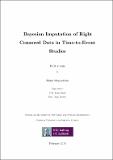| dc.contributor.advisor | Hinde, John | |
| dc.contributor.advisor | Newell, John | |
| dc.contributor.author | Moghaddam, Shirin | |
| dc.date.accessioned | 2018-04-09T11:40:32Z | |
| dc.date.issued | 2018-03-20 | |
| dc.identifier.uri | http://hdl.handle.net/10379/7257 | |
| dc.description.abstract | In time-to-event studies subjects are followed until the event of interest has happened.
Subjects who do not experience the event are referred to as censored. Due
to censoring, methods of plotting individual survival time, such as density plots,
are invalid. The graphical displays of time-to-event data usually take the form of
a Kaplan-Meier survival plot. However, using a Kaplan-Meier survival plot might
not be the most informative way to present the data to answer the typical questions
of interest. The median survival is often used as a summary of the survival experience
of a patients' population and it is easily read of the Kaplan-Meier plot. It
is unlikely however that the median is a relevant summary at the patient level and
a density plot of the data is perhaps more informative for communication than a
single summary statistic. A fundamental idea in this thesis is to consider censored
data as a form of missing, incomplete, data and use approaches from the missing
data literature to handle this issue. In particular, we will use the idea of imputing
the censored observations, based on the other information in the dataset and
some form of assumed model. By imputing values for the censored observations and
combining the original complete and imputed incomplete data, it is possible to plot
the density of the full data to complement the information given by Kaplan-Meier
plots. In this thesis, we consider using parametric Bayesian and non-parametric
Bayesian methods to impute right censored survival data to achieve this aim. The
imputation of censored observations not only allows more interpretable graphics to
be produced for a wider general audience (physicians and patients), but it opens
up the possibility of the use of standard formal methods of analysis for continuous
responses. | en_IE |
| dc.publisher | NUI Galway | |
| dc.rights | Attribution-NonCommercial-NoDerivs 3.0 Ireland | |
| dc.rights.uri | https://creativecommons.org/licenses/by-nc-nd/3.0/ie/ | |
| dc.subject | Survival analysis | en_IE |
| dc.subject | Bayesian analysis | en_IE |
| dc.subject | Censored data | en_IE |
| dc.subject | Imputation | en_IE |
| dc.subject | Mathematics, Statistics and Applied Mathematics | en_IE |
| dc.subject | Statistics | en_IE |
| dc.title | Bayesian imputation of right censored data in time-to-event studies | en_IE |
| dc.type | Thesis | en |
| dc.contributor.funder | Irish Research Council for Science, Engineering and Technology | en_IE |
| dc.local.note | The principal aim of this thesis was to consider censored data as a form of missing,
incomplete, data and to propose Bayesian approaches to impute these partially observed
values. In this thesis, the imputed values of censored observations were used
to produce more interpretable graphical summaries of time-to-event data, such as
a density plot, which may usefully complement Kaplan-Meier plots. The imputation
approach is intended to be used for the visual exploration and presentation of
survival data and give a simple, interpretable display for physicians and patients to
better understand summaries generated from time to event models. | en_IE |
| dc.description.embargo | 2022-03-20 | |
| dc.local.final | Yes | en_IE |
| nui.item.downloads | 90 | |


